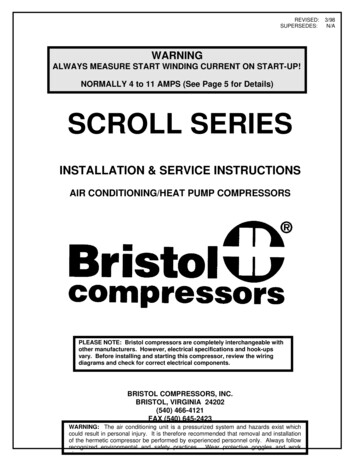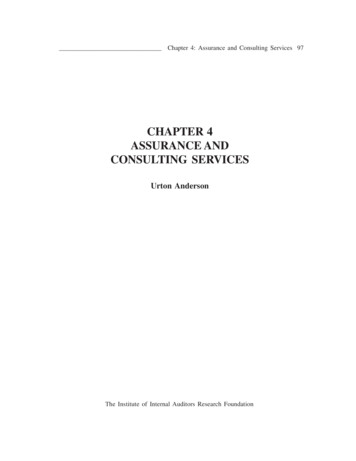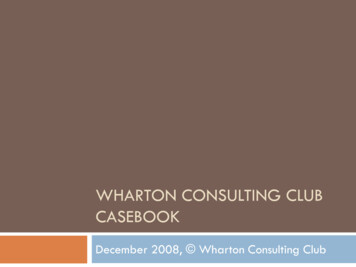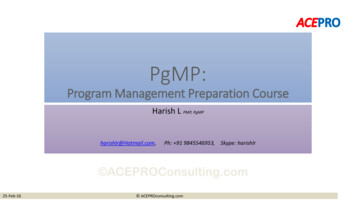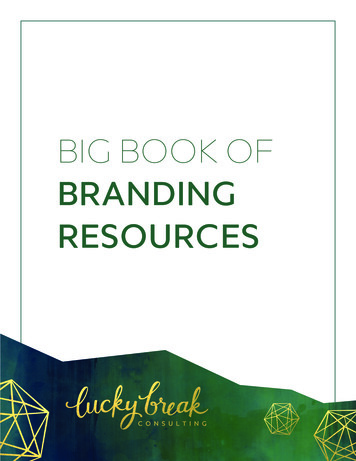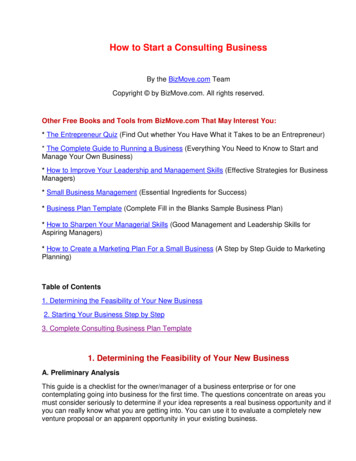
Transcription
How to Start a Consulting BusinessBy the BizMove.com TeamCopyright by BizMove.com. All rights reserved.Other Free Books and Tools from BizMove.com That May Interest You:* The Entrepreneur Quiz (Find Out whether You Have What it Takes to be an Entrepreneur)* The Complete Guide to Running a Business (Everything You Need to Know to Start andManage Your Own Business)* How to Improve Your Leadership and Management Skills (Effective Strategies for BusinessManagers)* Small Business Management (Essential Ingredients for Success)* Business Plan Template (Complete Fill in the Blanks Sample Business Plan)* How to Sharpen Your Managerial Skills (Good Management and Leadership Skills forAspiring Managers)* How to Create a Marketing Plan For a Small Business (A Step by Step Guide to MarketingPlanning)Table of Contents1. Determining the Feasibility of Your New Business2. Starting Your Business Step by Step3. Complete Consulting Business Plan Template1. Determining the Feasibility of Your New BusinessA. Preliminary AnalysisThis guide is a checklist for the owner/manager of a business enterprise or for onecontemplating going into business for the first time. The questions concentrate on areas youmust consider seriously to determine if your idea represents a real business opportunity and ifyou can really know what you are getting into. You can use it to evaluate a completely newventure proposal or an apparent opportunity in your existing business.
Perhaps the most crucial problem you will face after expressing an interest in starting a newbusiness or capitalizing on an apparent opportunity in your existing business will bedetermining the feasibility of your idea. Getting into the right business at the right time is simpleadvice, but advice that is extremely difficult to implement. The high failure rate of newbusinesses and products indicates that very few ideas result in successful business ventures,even when introduced by well established firm. Too many entrepreneurs strike out on abusiness venture so convinced of its merits that they fail to thoroughly evaluate its potential.This checklist should be useful to you in evaluating a business idea. It is designed to help youscreen out ideas that are likely to fail before you invest extensive time, money, and effort inthem.Preliminary AnalysisA feasibility study involves gathering, analyzing and evaluating information with the purpose ofanswering the question: "Should I go into this business?" Answering this question involves firsta preliminary assessment of both personal and project considerations.General Personal ConsiderationsThe first seven questions ask you to do a little introspection. Are your personalitycharacteristics such that you can both adapt to and enjoy business ownership/management?1. Do you like to make your own decisions?2. Do you enjoy competition?3. Do you have will power and self-discipline?4. Do you plan ahead?5. Do you get things done on time?6. Can you take advise from others?7. Are you adaptable to changing conditions?The next series of questions stress the physical, emotional, and financial strains of a newbusiness.8. Do you understand that owning your own business may entail working 12 to 16 hours aday, probably six days a week, and maybe on holidays?9. Do you have the physical stamina to handle a business?10. Do you have the emotional strength to withstand the strain?11. Are you prepared to lower your standard of living for several months or years?12. Are you prepared to loose your savings?Specific Personal Considerations
1. Do you know which skills and areas of expertise are critical to the success of your project?2. Do you have these skills?3. Does your idea effectively utilize your own skills and abilities?4. Can you find personnel that have the expertise you lack?5. Do you know why you are considering this project?6. Will your project effectively meet your career aspirationsThe next three questions emphasize the point that very few people can claim expertise in allphases of a feasibility study. You should realize your personal limitations and seek appropriateassistance where necessary (i.e. marketing, legal, financial).7. Do you have the ability to perform the feasibility study?8. Do you have the time to perform the feasibility study?9. Do you have the money to pay for the feasibility study done?General Project Description1. Briefly describe the business you want to enter.2. List the products and/or services you want to sell3. Describe who will use your products/services4. Why would someone buy your product/service?5. What kind of location do you need in terms of type of neighborhood, traffic count, nearbyfirms, etc.?6. List your product/services suppliers.7. List your major competitors - those who sell or provide like products/services.
8. List the labor and staff you require to provide your products/services.B. Requirements For SuccessTo determine whether your idea meets the basic requirements for a successful new project,you must be able to answer at least one of the following questions with a "yes."1. Does the product/service/business serve a presently unserved need?2. Does the product/service/business serve an existing market in which demand exceedssupply?3. Can the product/service/business successfully compete with an existing competitionbecause of an "advantageous situation," such as better price, location, etc.?Major FlawsA "Yes" response to questions such as the following would indicate that the idea has littlechance for success.1. Are there any causes (i.e., restrictions, monopolies, shortages) that make any of therequired factors of production unavailable (i.e., unreasonable cost, scare skills, energy,material, equipment, processes, technology, or personnel)?2. Are capital requirements for entry or continuing operations excessive?3. Is adequate financing hard to obtain?4. Are there potential detrimental environmental effects?5. Are there factors that prevent effective marketing?C. Desired IncomeThe following questions should remind you that you must seek both a return on yourinvestment in your own business as well as a reasonable salary for the time you spend inoperating that business.1. How much income do you desire?2. Are you prepared to earn less income in the first 1-3 years?
3. What minimum income do you require?4. What financial investment will be required for your business?5. How much could you earn by investing this money?6. How much could you earn by working for someone else?7. Add the amounts in 5 and 6. If this income is greater that what you can realistically expectfrom your business, are you prepared to forego this additional income just to be your own bosswith the only prospects of more substantial profit/income in future years?8. What is the average return on investment for a business of your type?D. Preliminary Income StatementBesides return on investment, you need to know the income and expenses for your business.You show profit or loss and derive operating ratios on the income statement. Dollars are the(actual, estimated, or industry average) amounts for income and expense categories.Operating ratios are expressed as percentages of net sales and show relationships ofexpenses and net sales.For instance 50,000 in net sales equals 100% of sales income (revenue). Net profit after taxesequals 3.14% of net sales. The hypothetical "X" industry average after tax net profit might be5% in a given year for firms with 50,000 in net sales. First you estimate or forecast income(revenue) and expense dollars and ratios for your business. Then compare your estimated oractual performance with your industry average. Analyze differences to see why you are doingbetter or worse than the competition or why your venture does or doesn't look like it will float.These basic financial statistics are generally available for most businesses from trade andindustry associations, government agencies, universities and private companies and banksForecast your own income statement. Do not be influenced by industry figures. Your estimatesmust be as accurate as possible or else you will have a false impression.1. What is the normal markup in this line of business. i.e., the dollar difference between thecost of goods sold and sales, expressed as a percentage of sales?
2. What is the average cost of goods sold percentage of sales?3. What is the average inventory turnover, i.e., the number of times the average inventory issold each year?4. What is the average gross profit as a percentage of sales?5. What are the average expenses as a percentage of sales?6. What is the average net profit as a percent of sales?7. Take the preceding figures and work backwards using a standard income statement formatand determine the level of sales necessary to support your desired income level.8. From an objective, practical standpoint, is this level of sales, expenses and profitattainable?
E. Market AnalysisThe primary objective of a market analysis is to arrive at a realistic projection of sales. afteranswering the following questions you will be in a better positions to answer question eightimmediately above.Population1. Define the geographical areas from which you can realistically expect to draw customers.2. What is the population of these areas?3. What do you know about the population growth trend in these areas?4. What is the average family size?5. What is the age distribution?
6. What is the per capita income?7. What are the consumers' attitudes toward business like yours?8. What do you know about consumer shopping and spending patterns relative to your type ofbusiness?9. Is the price of your product/service especially important to your target market?10. Can you appeal to the entire market?11. If you appeal to only a market segment, is it large enough to be profitable?F. Competition1. Who are your major competitors?2. What are the major strengths of each?3. What are the major weaknesses of each?4. Are you familiar with the following factors concerning your competitors:Price structure?Product lines (quality, breadth, width)?Location?
Promotional activities?Sources of supply?Image from a consumer's viewpoint?5. Do you know of any new competitors?6. Do you know of any competitor's plans for expansion?7. Have any firms of your type gone out of business lately?8. If so, why?9. Do you know the sales and market share of each competitor?10. Do you know whether the sales and market share of each competitor are increasing,decreasing, or stable?11. Do you know the profit levels of each competitor?12. Are your competitors' profits increasing, decreasing, or stable?13. Can you compete with your competition?G. Sales1. Determine the total sales volume in your market area.
2. How accurate do you think your forecast of total sales is?3. Did you base your forecast on concrete data?4. Is the estimated sales figure "normal" for your market area?5. Is the sales per square foot for your competitors above the normal average?6. Are there conditions, or trends, that could change your forecast of total sales?7. Do you expect to carry items in inventory from season to season, or do you plan to markdown products occasionally to eliminate inventories? If you do not carry over inventory, haveyou adequately considered the effect of mark-down in your pricing? (Your gross profits marginmay be too low.)8. How do you plan to advertise and promote your product/service/business?9. Forecast the share of the total market that you can realistically expect - as a dollar amountand as a percentage of your market.10. Are you sure that you can create enough competitive advantages to achieve the marketshare in your forecast of the previous question?11. Is your forecast of dollar sales greater than the sales amount needed to guarantee yourdesired or minimum income?12. Have you been optimistic or pessimistic in your forecast of sales?13. Do you need to hire an expert to refine the sales forecast?14. Are you willing to hire an expert to refine the sales forecast?
H. Supply1. Can you make a list of every item of inventory and operating supplies needed?2. Do you know the quantity, quality, technical specifications, and price ranges desired?3. Do you know the name and location of each potential source of supply?4. Do you know the price ranges available for each product from each supplier?5. Do you know about the delivery schedules for each supplier?6. Do you know the sales terms of each supplier?7. Do you know the credit terms of each supplier?8. Do you know the financial condition of each supplier?9. Is there a risk of shortage for any critical materials or merchandise?10. Are you aware of which supplies have an advantage relative to transportation costs?11. Will the price available allow you to achieve an adequate markup?I. Expenses1. Do you know what your expenses will be for: rent, wages, insurance, utilities, advertising,interest, etc?2. Do you need to know which expenses are Direct, Indirect, or Fixed?3. Do you know how much your overhead will be?4. Do you know how much your selling expenses will be?Miscellaneous1. Are you aware of the major risks associated with your product? Service Business?2. Can you minimize any of these major risks?3. Are there major risks beyond your control?4. Can these risks bankrupt you? (fatal flaws)J. Venture Feasibility
1. Are there any major questions remaining about your proposed venture?2. Do the above questions arise because of a lack of data?3. Do the above questions arise because of a lack of management skills?4. Do the above questions arise because of a "fatal flaw" in your idea?5. Can you obtain the additional data needed?Go to Top2. Starting Your Business Step by StepA. Things to Consider Before You StartThis guide will walk you step by step through all the essential phases of starting a successfulservice business. To profit in a service based business, you need to consider the followingquestions: What business am I in? What services do I provide? Where is my market? Who willbuy? Who is my competition? What is my sales strategy? What merchandising methods will Iuse? How much money is needed to operate my firm? How will I get the work done? Whatmanagement controls are needed? How can they be carried out? When should I revise myplan? And many more.No one can answer such questions for you. As the owner-manager you have to answer themand draw up your business plan. The pages of this guide are a combination of text andworkspaces so you can write in the information you gather in developing your business plan - alogical progression from a commonsense starting point to a commonsense ending point.It takes time and energy and patience to draw up a satisfactory business plan. Use this Guideto get your ideas and the supporting facts down on paper. And, above all, make changes inyour plan on these pages as that plan unfolds and you see the need for changes.Bear in mind that anything you leave out of the picture will create an additional cost, or drainon your money, when it crops up later on. If you leave out or ignore enough items, yourbusiness is headed for disaster.Keep in mind too, that your final goal is to put your plan into action. More will be said about thisnear the end of this Guide.What's in this for Me?You may be thinking: Why should I spend my time drawing up a business plan? What's in it forme? If you've never drawn up a plan, you are right in wanting to hear about the possiblebenefits before you do your work.A business plan offers at least four benefits. You may find others as you make and use such aplan. The four are:
(1) The first, and most important, benefit is that a plan gives you a path to follow. A plan makesthe future what you want it to be. A plan with goals and action steps allows you to guide yourbusiness through turbulent economic seas and into harbors of your choice. The alternative isdrifting into "any old port in a storm."(2) A plan makes it easy to let your banker in on the action. By reading, or hearing, the detailsof your plan he will have real insight into your situation if he is to lend you money.(3) A plan can be a communications tool when you need to orient sales personnel, suppliers,and others about your operations and goals.(4) A plan can help you develop as a manager. It can give you practice in thinking aboutcompetitive conditions, promotional opportunities, and situation that seem to be advantageousto your business. Such practice over a period of time can help increase an owner-manager'sability to make judgments.Why am I in Business?Many enterprising people are drawn into starting their own business by the possibilities ofmaking money and being their own boss. But the long hours, hard work, and responsibilities ofbeing the boss quickly dispel and preconceived glamour.Profit is the reward for satisfying consumer needs. But it must be worked for. Sometimes anew business might need two years before it shows a profit. So where, then, are reasons forhaving your own business?Every business owner-manager will have his or her own individual reasons for being inbusiness. For some, satisfaction come from serving their community. They take pride inserving their neighbors and giving them quality work which they stand behind. For others, theirbusiness offers them a chance to contribute to their employees' financial security.There are as many rewards and reasons for being in business as there are business owners.Why are you in business?What business am I in?In making your business plan, the first question to consider is: What business am I really in. Atthe first reading this question may seem silly. "If there is one thing I know," you say to yourself,"it is what business I'm in." But hold on. Some owner-managers go broke and others wastetheir saving because they are confused about the business they are in.The changeover of barbershops from cutting hair to styling hair is one example of thinkingabout what business you're really in.Consider this example, also. Joe Riley had a small radio and TV store. He thought of hisbusiness as a retail store though he also serviced and repaired anything he sold. As his suburb
grew, appliance stores emerged and cut heavily into his sales. However, there was anincreased call for quality repair work.When Mr. Riley considered his situation, he decided that he was in the repair business. As aresult of thinking about what business he was really in, he profitably built up his repair businessand has a contract to take care of the servicing and repair business for one of the appliancestores.Decide what business you are in and write your answer in the following spaces. To help youdecide, think of the answers to questions such as: What inventory of parts and materials mustyou keep on hand? What services do you offer? What services do people ask for that you donot offer? What is it you are trying to do better, more of, or differently from your competitors?How to Plan Your MarketingWhen you have decided what business you're in, you have made your first marketing decision.Now you are ready for other important considerations.Successful marketing starts with the owner-manager. You have to know your service and theneeds of your customers.The narrative and work blocks that follow are designed to help you work out a marketing planfor your firm. The blocks are divided into three sections:Section One - Determining the Sales PotentialSection Two - Attracting CustomersSection Three - Selling to CustomersSection One - Determining the Sales PotentialIn the service business, your sales potential will depend on the area you serve. That is, howmany customers in this area will need your services? Will your customers be industrial,commercial, consumer, or all of these?When picking a site to locate your business, consider the nature of your service. If you pick upand deliver, you will want a site where the travel time will be low and you may later install aradio dispatch system. Or, if the customer must come to your place of business, the site mustbe conveniently located and easy to find.You must pick the site that offers the best possibilities of being profitable. The followingquestions will help you think through this problem.In selecting an area to serve, consider the following:Population and its growth potentialIncome, age, occupation of population
Number of competitive services in and around your proposed locationLocal ordinances and zoning regulationsType of trading area (commercial, industrial, residential, seasonal)For additional help in choosing an area, you might try the local chamber of commerce and themanufacturer and distributor of any equipment and supplies you will be using.You will want to consider the next list of questions in picking the specific site for your business:Will the customer come to your place of business?How much space do you need?Will you want to expand later on?Do you need any special features required in lighting, heating, ventilation?Is parking available?Is public transportation available?Is the location conducive to drop-in customers?Will you pick up and deliver?Will travel time be excessive?Will you prorate travel time to service call?Would a location close to an expressway or main artery cut down on travel time?If you choose a remote location, will savings in rent off-set the inconvenience?If you choose a remote location, will you have to pay as much as you save in rent foradvertising to make your service known?If you choose a remote location, will the customer be able to readily locate your business?Will the supply of labor be adequate and the necessary skills available?What are the zoning regulations of the area?Will there be adequate fire and police protection?Will crime insurance be needed and be available at a reasonable rate?I plan to locate in because:
Is the area in which you plan to locate supported by a strong economic base? For example,are nearby industries working full time? Only part time? Did any industries go out of businessin the past several months? Are new industries scheduled to open in the next several months?Write your opinion of the area's economic base and your reason for that opinion here.:Will you build? What are the terms of the loan or mortgage?Will you rent? What are the terms of the lease?Is the building attractive? In good repair?Will it need remodeling? Cost of remodeling?What services does the landlord provide?What is the competition in the area you have picked?The number of firms that handle my serviceDoes the area appear to be saturated?How many of these firms look prosperous?Do they have any apparent advantages over you?How many look as though they're barely getting by?How many similar services went out of business in the area last year?Can you find out why they failed?How many new services opened up in the last year?How much do your competitors charge for your service?Which firm or firms in the area will be your biggest competition?List the reasons for your opinion here:
Section Two - Attracting CustomersWhen you have a location in mind, you should work through another aspect of marketing. Howwill you attract customers to your business? How will you pull customers away from yourcompetition?It is working with this aspect of marketing that many service firms find competitive advantages.The ideas which they develop are as good and often better, than those which large companiesdevelop with hired brains. The workblocks that follow are designed to help you think aboutimage, pricing, customer service policies, and advertising.ImageWhether you like it or not, your service business is going to have an image. The way peoplethink of your firm will be influenced by the way you conduct your business. If people come toyour place of business for your service, the cleanliness of the floors, the manner in which theyare treated, and the quality of your work will help form your image. If you take your service tothe customer, the conduct of your employees will influence your image. Pleasant, prompt,courteous service before and after the sale will help make satisfied customers your best formof advertising.Thus, you can control your image, Whatever image you seek to develop. It should be concreteenough to promote in your advertising. For example, "service with a smile" is an often usedimage.Write out what image you want customers to have of your business.PricingIn setting prices for your service, there are four main elements you must consider:(1) Materials and supplies(2) Labor and operating expenses(3) Planned profit(4) CompetitionFurther along in this Guide you will have the opportunity to figure out the specifics of materials,supplies, labor, and operating expenses. From there you may want the assistance of youraccountant in developing a price structure that will not only be fair to the customer, but also fairto yourself. This means that not only must you cover all expenses but also allow enoughmargin to pay yourself a salary.
One other thing to consider. Will you offer credit? Most businesses use a creditcard system. These credit costs have to come from somewhere. Plan for them. If you use acredit card system, what will it cost you?Can you add to your prices to absorb this cost?Some trade association have a schedule for service charges. It would be a good idea to checkwith the trade association for your line of business. Their figures will make a good yardstick tomake sure your prices are competitive.And, of course, your prices must be competitive. You've already found out your competitors'prices. Keep these in mind when you are working with your accountant. If you will not be ableto make an adequate return, now is the time to find out.Customer Service PoliciesCustomers expect certain services or conveniences, for example, parking. These services maybe free to the customer, but not to you. If you do provide parking, you either pay for your ownlot or pick up your part of the cost of a lot which you share with other businesses. Since theseconveniences will be an expense, plan for them.List the services that your competitors provide to customers:Now list the services that you will provide your customers:Service / Estimated CostPlanning Your Advertising ActivitiesIn this section on attracting customers, advertising was saved until last because you have tohave something to say before advertising can be effective. When you have an image, pricerange, and customers services, you are ready to tell prospective customers why they shoulduse your services.When the money you can spend on advertising is limited it is vital that your advertising be ontarget. Before you can think about how much money you can afford for advertising, take timeto determine what jobs you want advertising to do for your business. The work blanks thatfollow should be helpful to your thinking.
The strong points about my service business are:My service business is different from my competition in the following ways:My advertising should tell customers and prospective customers the following facts about mybusiness and services:When you have these facts in mind, you now need to determine who you are going to tell it to.Your advertising needs to be aimed at a target audience - those people who are most likely touse your services. In the spacebelow, describe your customers in terms of age, sex, occupation, and whatever else isnecessary depending on the nature of your business. This is your customer profile of "maleand female automobile owners, 18 years old and above." Thus, for this repair business,anyone over 18 who owns a car is likely to need its service.The customer profile for my business isNow you are ready to think about the form your advertising should take and its cost. You arelooking for the most effective means to tell your story to those most likely to use your service.Ask the local media (newspapers, radio and television, and the printers of direct mail pieces)for information about the services and the results they offer for your money.How you spend advertising money is your decision, but don't fall into the trap that snares manyadvertisers. As one consultant describes this pitfall: It is amazing the way many managersconsider themselves experts on advertising copy and media selection without any experiencein these areas.The following blanks should be useful in determining what advertising is needed to sell yourstrong points to prospective customers.When you have a figure on what your advertising for the next 12 months will cost, check itagainst one of the operating ratios (expenses as a percentage of sales) which tradeassociations and other organizations gather. If your estimated cost for advertising is
substantially higher than this average for your line of service, take a second look. No singleexpense item should be allowed to get way out of line if you want to make a profit. Your task indetermining comes down to: How much can I afford to spend and still do the job that needs tobe done?Section Three - Selling to CustomersTo complete your work on marketing, you need to think about what you want to happen afteryou get a customer. Your goal is to provide your service, satisfy customers, and put moneyinto the cash register.One-time customers can't do the job. You need repeat customers to build a profitable annualsales volume. When someone returns for your service, it is probably because he was satisfiedby his previous experience. Satisfied customers are the best form of advertising.If you previously decided to work only for cash, take a hard look at your decision. Americanslike to buy on credit. Often a credit card, or other system of credit and collections, is needed toattract and hold customers.Based on this description and the dollar amount of business you indicated that you intend to dothis year, fill in the following workblocks.Fixtures and EquipmentNo matter whether or not customers wil
Other Free Books and Tools from BizMove.com That May Interest You: * The Entrepreneur Quiz (Find Out whether You Have What it Takes to be an Entrepreneur) * The Complete Guide to Running a Business (Everything You Need to Know to Start
